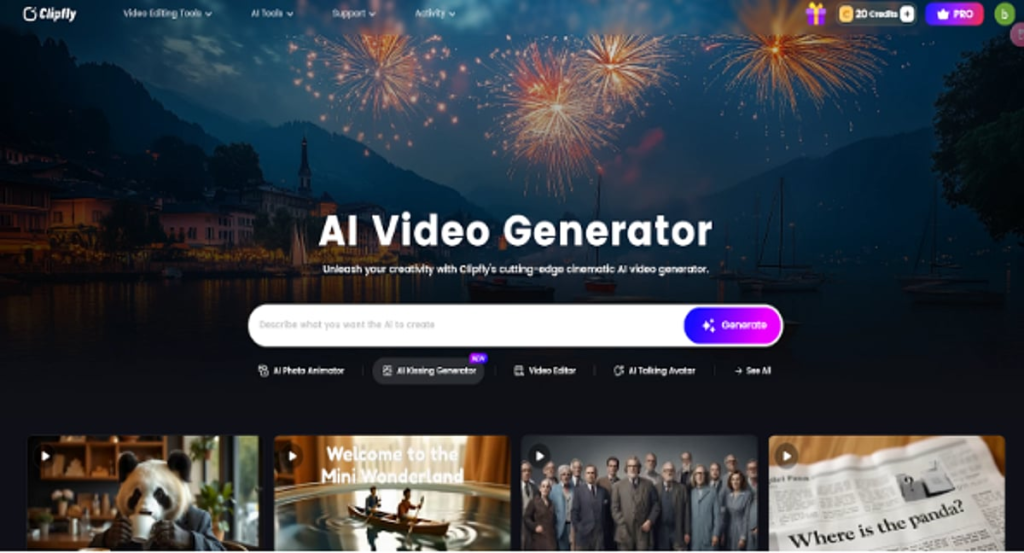In an increasingly competitive landscape, small and medium-sized businesses (SMBs) are turning to automation and AI tools to streamline operations and improve productivity. Two popular options for video content creation and editing are Clipfly and Lumen5. Each tool offers unique features, advantages, and drawbacks tailored to different business needs.
Clipfly allows users to input a straightforward description of their videos or select from preset options if inspiration is lacking. This feature is particularly valuable for teams that may not have a dedicated creative resource. Furthermore, Clipfly enables users to specify elements to avoid, providing a more customized creation process. Its intuitive interface simplifies the journey from concept to completion, making it ideal for SMBs looking to produce content quickly and with minimal overhead.
On the other hand, Lumen5 provides a more guided approach to video creation. Its AI-driven platform converts text content into videos, using a library of media assets to customize visual storytelling. This makes it an excellent choice for brands with existing written material, such as blogs or articles, as it allows for seamless content repurposing. Lumen5 also offers a wider range of templates and themes, appealing to businesses focused on brand consistency and visual identity.
Both platforms have their strengths, but they confer different advantages based on business needs. Reliability is a crucial factor to consider. Clipfly has garnered positive feedback for its performance speed and user experience. However, Lumen5’s more extensive library of images and videos may lead to a richer content output, especially if a business relies heavily on high-quality visuals. In environments where speed is essential, Clipfly may be the more suitable option.
Pricing structures vary between the two tools. Clipfly typically offers a tiered subscription model that makes it cost-effective for smaller teams. The basic plan suits SMBs needing fundamental features, while higher-tier plans provide advanced options like analytics and collaboration tools. In contrast, Lumen5 operates on a freemium model, which can be appealing for startups. It allows limited access to features before committing to a paid plan. However, advanced features and removal of watermarks come with higher subscription tiers, which might be a consideration for budget-constrained businesses.
Integration capabilities are also pivotal in choosing the right tool. Clipfly supports various platforms, enabling simple integration into existing workflows. Pairing it with tools like Slack or Trello can enhance project management efficiency. Lumen5 also provides numerous integration opportunities with services like WordPress and HubSpot, allowing businesses to streamline content sharing across platforms. Companies with established workflows or a need for collaborative content might find Lumen5’s integrations particularly useful.
When assessing limits, both platforms have unique constraints. Clipfly’s quick generation process can lead to less customizable edits unless users move to the advanced tiers. In contrast, Lumen5’s diverse media assets may appeal to users seeking more visual engagement but can become overwhelming if a user is unfamiliar with the extensive options available. Thus, businesses should evaluate the importance of customization against the need for simplicity.
Support options for either tool vary considerably. Clipfly provides robust online resources and a responsive support team, making it easier for users to navigate challenges. Conversely, Lumen5 offers an extensive knowledge base and community forums, which can be advantageous for users who prefer self-service solutions. Depending on an organization’s technical proficiency, one tool may offer a more suitable level of support than the other.
For businesses looking to migrate from one platform to another, it is prudent to conduct a low-risk pilot. Businesses can select a small project and use that to evaluate Clipfly’s and Lumen5’s features. Whether testing Clipfly’s quick video generation or Lumen5’s text-to-video capabilities, using a new tool on a limited basis helps assess ease of use and suitability. Training sessions can be arranged for staff to ensure smooth adoption, demonstrating a commitment to minimizing disruption.
Total cost of ownership needs careful consideration for long-term planning. Businesses should evaluate subscription costs alongside any added expenses for premium features or integrations. Anticipated returns on investment should be analyzed over a three- to six-month period. The efficiency gains from faster video production and enhanced marketing outreach could translate into increased leads and customer engagement, offering a compelling case for investing in automation tools.
FlowMind AI Insight: Selecting the right video content creation tool requires a comprehensive evaluation of business needs, existing workflows, and budget constraints. By weighing features, pricing, and reliability, SMBs can make informed decisions that drive efficiency and ROI while reducing operational risks. Ultimately, adopting the appropriate platform can empower businesses to produce high-quality content that resonates with their audience and bolsters overall growth.
Original article: Read here
2025-01-15 08:00:00

